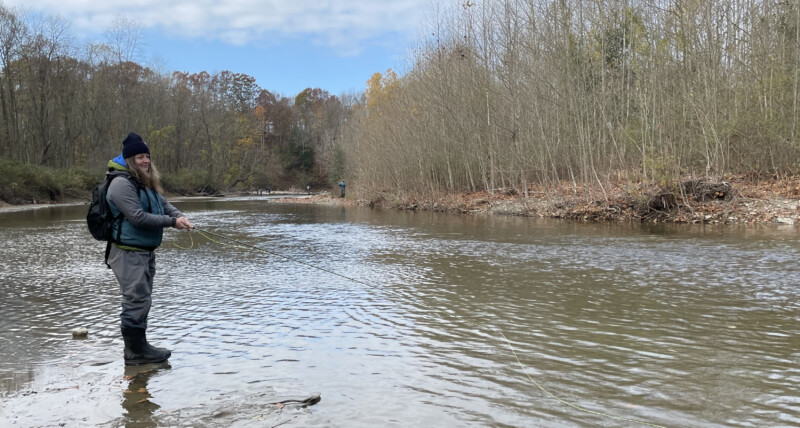
Fishing is one of the many recreational activities in Pennsylvania that can be enjoyed year-round. Whether it’s a balmy 40 degrees F day by the stream or -20 degrees F out on the ice, basic layering is key to a safe and comfortable fishing adventure.
Simply layering with lots of random clothes will leave you damp and shivering. Proper layering can be the difference between a long, successful day of fishing and a cold, frustrating afternoon.
1. Base Layer
The base layer is the layer next to your skin. It’s main purpose is to wick perspiration away from the body so it passes to the next layer. In order to stay comfortable, manmade fibers are a great option. Materials like merino wool and the newest compression garments that fit like a second skin are common base layers. Silk is also a form-fitting option without the tightness of compression garments.
2. Insulation Layer
The insulation layer should create space to trap warm air from escaping but allow perspiration in the form of water vapor to pass to the next layer. Goose down has often been the go-to as an insulator in outdoor clothing, but it doesn’t let perspiration escape easily so you can become overheated. Also, down is bulky and doesn’t dry quickly.
Today’s best insulation materials are Polar Fleece or Thinsulate™—warmth without weight or bulk. Quality fleece is relatively inexpensive, allows moisture to pass through, retains insulating abilities when wet, and it dries very quickly. Vests, hats, neck gators, long pants and pull-over/zippered tops are all available in fleece.
3. Shell Layer
The outermost shell layer should be windproof and waterproof, yet breathable so all that perspiration can escape—otherwise inner layers will become damp and you’ll end up shivering.
Several high-tech materials like Gore-Tex®, Dry-Plus®, Tech H2O™ and textured nylon are perfect for winter. The key is to purchase waterproof shell clothing where the manufacturer states the material is breathable, and not through vents or inner mesh lining. Rubberized or PVC material never breathes and should be avoided.
To be comfortable, layering should extend to the entire body: including long-sleeve tops and long bottoms.
4. Head, Hands, and Toes
The head is an area of significant heat loss, so it’s important to keep it covered. Depending on your need, a simple ball cap could work. But for more coverage and warmth, you may want a neck gaiter and tightly knit beanie or a Thinsulate™/Gore-Tex® ball cap.
If you’re fishing with a rod and reel where feel is important, fingerless gloves in either ragg wool or fleece are popular. Take two or three pairs along in case one gets wet.
When hauling a sled onto the ice or paddling a kayak, you need the protection of full-finger lined, waterproof gloves.
Be sure to slip on liner socks and insulating socks before stepping into a shoe or boot.
For added warmth of toes and fingers, look to the magic of hand or toe warmers. Slip hand warmers into your jacket pockets to bring feeling back into your hands. Toe warmers come with adhesive strips to the bottom of your socks to keep your feet warm throughout the day.
5. Adjust the “Thermostat”
Some people can withstand cold better than others. You may require more or less insulation than your buddy to maintain the same comfort level. Be sure to pack for all scenarios and read the signs your body is telling you.
Remember these do’s and don’ts for staying warm and dry in winter weather:
DO: Choose an insulation layer that holds warm air but doesn’t absorb water, like merino wool. This is the perfect option to keep body heat in while wicking any sweat or moisture. Wear a waterproof outer layer that prevents rain, snow or wind from penetrating your insulation.
DON’T: Wear cotton. Cotton is a poor cold-weather clothing choice because it retains moisture. Avoid a rubberized outer shell. This creates a waterproof barrier for sure, but at the same time it doesn’t let moisture escape, which you’ll need to stay warm and dry.
Happy Fishing!
Adapted from “Dressing for Successful Cold-Weather Angling” article in Pennsylvania Angler & Boater Magazine.



